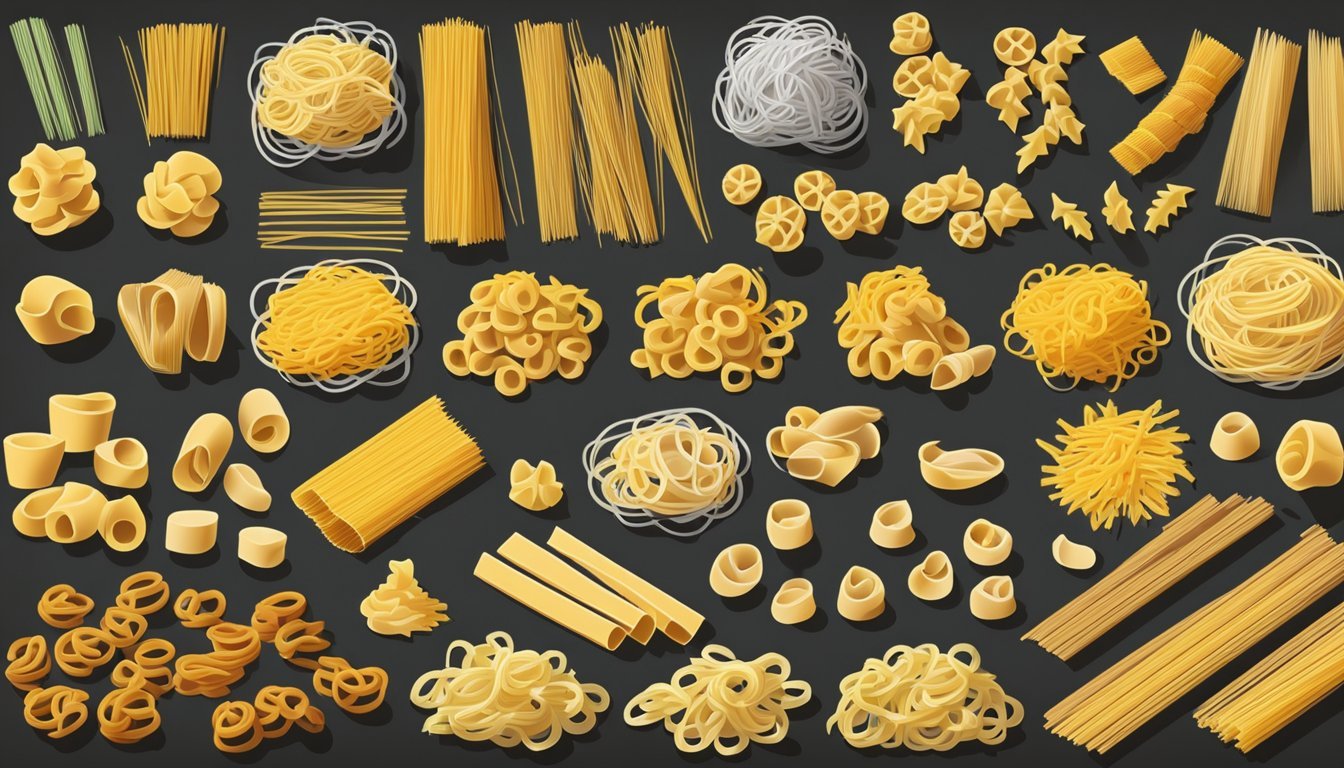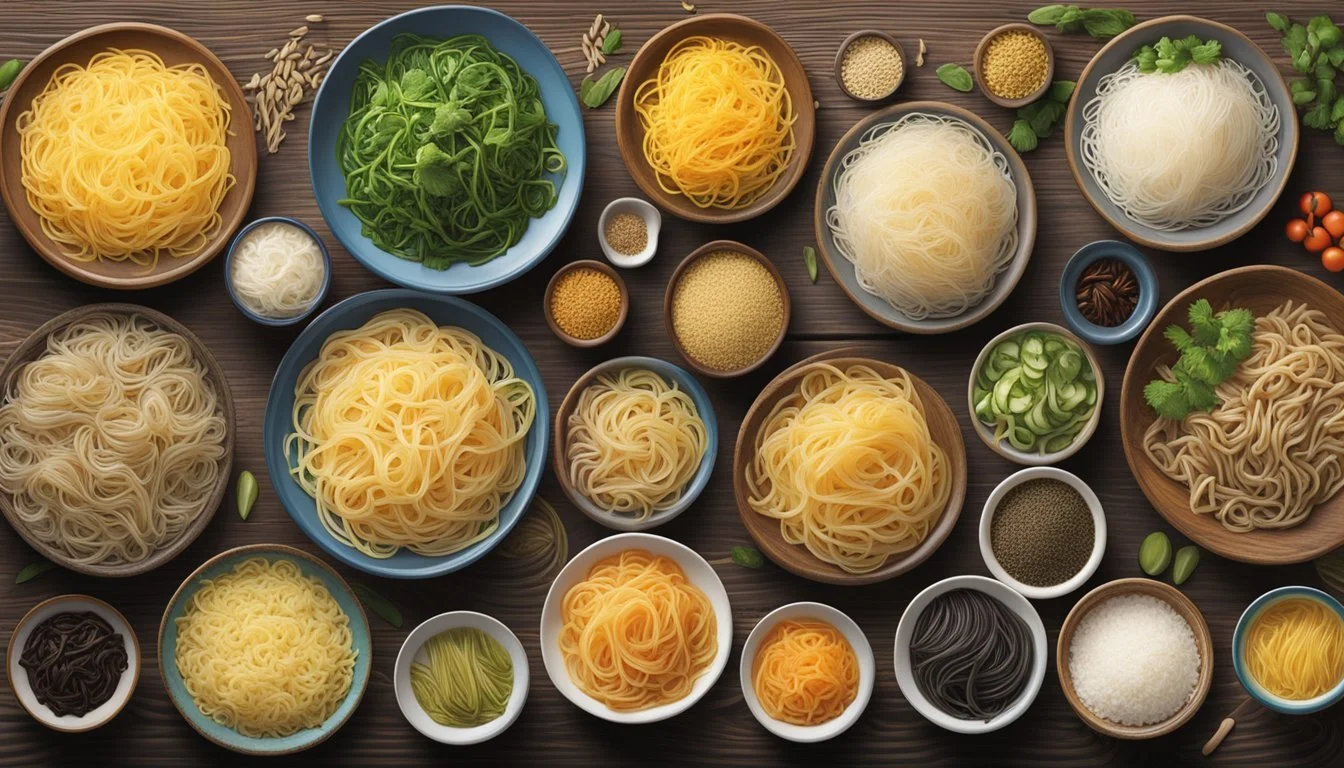Vermicelli Pasta Substitutes
Top Alternatives for Your Noodle Dishes
Vermicelli pasta, a thin and delicate form of traditional Italian noodles, has been a staple in many pasta (What wine goes well with pasta?) dishes due to its versatility and quick cooking time. However, there are occasions when one might seek alternatives to vermicelli, whether due to dietary restrictions, texture preference, or simply the need for variety in cooking. Fortunately, there is an array of suitable substitutes that maintain the integrity of the dishes while adding their unique characteristics.
Among the alternatives, linguine stands out as a thicker option that can seamlessly integrate into recipes that traditionally employ vermicelli. Its ability to hold onto lighter sauces makes it a suitable replacement in many Italian dishes. For those looking for a gluten-free option or catering to Asian-inspired recipes, rice noodles provide an excellent substitute. Their slightly chewy texture and adaptability in a variety of dishes, from stir-fries to noodle salads, make them a popular choice in both Vietnamese and Thai cuisine.
Additionally, bucatini, a pasta resembling thicker spaghetti with a hollow center, offers another creative alternative. Bucatini's distinctive texture and ability to absorb sauces lend itself well to dishes that require a heartier noodle. Whether one's priority is matching the texture, adapting to a specific cuisine, or exploring new pasta horizons, these substitutes for vermicelli pasta ensure that the culinary experience remains rich and satisfying.
Understanding Vermicelli Pasta
Vermicelli pasta plays a pivotal role in diverse culinary traditions, from Italian to Asian cuisines, where its unique texture and flavor profile are essential in an array of recipes.
Origins and Types
Vermicelli, meaning "little worms" in Italian, is a traditional pasta in Italian cuisine. There are two primary types of vermicelli: Italian and Asian. The Italian version is made from durum wheat semolina, and is thicker than its Asian counterpart, which often consists of rice flour or mung bean starch.
Texture and Flavor Profile
Vermicelli is known for its delicate, fine strands that offer a slightly chewy texture when cooked. In flavor, it is subtly refined, making it a versatile ingredient in various dishes. It absorbs flavors like olive oil, light creamy sauces, and tomato-based sauces well due to its slender shape.
Typical Dishes Using Vermicelli
In Italian dishes, vermicelli is commonly found in light, brothy soups (What wine goes well with soups?), seafood dishes, and simple recipes complemented by olive oil and fresh herbs. Across Asian cuisines, vermicelli is a staple in stir-fries, salads, and iconic dishes like Pho and Pad Thai, offering a complementary texture and capability to meld with bold flavors.
Ideal Substitutes for Vermicelli Pasta
When searching for vermicelli pasta substitutes, one should consider dietary needs like gluten intolerance, the desired texture in the finished dish, and flavor compatibility. The substitutes range across various types of noodles, ensuring there is a suitable option for nearly any recipe.
Gluten-Free Alternatives
For gluten-sensitive individuals, rice noodles serve as an excellent replacement. These noodles are made from rice flour and water, offering a similar delicate texture and mild taste. They're particularly apt in Asian cuisine. Shirataki noodles, which are long, gelatinous noodles made from the konjac yam, are another low-carb and gluten-free substitute that are high in fiber and can mimic the texture of vermicelli.
Substitutes by Texture
If texture is your primary concern, angel hair pasta (capellini) is a close match with its thin strands, making it a good swap in Italian dishes. Spaghetti can also work when vermicelli isn’t available, though it's slightly thicker. Asian dishes often use rice stick noodles or flat thick rice noodles, which have a chewiness that stands up well in stir-fries and soups.
Flavor Complementary Substitutes
When flavor pairing is vital, consider udon noodles for their subtle taste, which doesn't overpower delicate sauces. Chinese egg noodles provide a similar profile, with a touch more egg flavor, complementing richer sauces and broths. These noodles absorb flavors well, allowing them to seamlessly integrate into the dishes that traditionally call for vermicelli.
Culinary Considerations for Substitutes
Choosing a substitute for vermicelli pasta involves more than just swapping one noodle for another. It requires attention to details such as cooking times and interactions with sauces to ensure a harmonious dish.
Cooking Times and Techniques
Different pasta types have varying cooking times. For example, linguine takes about 9 to 13 minutes to cook to al dente, while rice noodles can be ready in less than 5 minutes by just soaking in hot water until pliable. It is crucial to adjust the time spent in cooking water accordingly to prevent a substitute from becoming too soft or too hard. When substituting for vermicelli, one must also consider the pasta shape, as it influences the texture and bite of the final dish.
Sauce Pairings with Substitutes
The type of sauce can make or break a pasta dish. Substitutes for vermicelli should pair well with traditional sauces like tomato sauce, pesto, carbonara, alfredo, and marinara sauce. Linguine is a fitting alternative that works well with thinner sauces due to its surface area, which allows sauces to cling to the pasta. Conversely, rice noodles are often used in lighter, vegetable-based or dairy sauces prevalent in Asian cuisine.
Tomato-based sauces: Bucatini, with its hollow center, complements the thickness of a rich marinara.
Creamy sauces: Linguine pairs well with dairy sauces such as carbonara and alfredo.
Oil-based sauces: Angel hair (Capelli d’angelo) is a suitable choice for lighter olive oil-based sauces.
Nutritional Considerations
Substitutes can vary significantly in nutritional content. For individuals with dietary restrictions, alternatives like rice noodles offer a gluten-free option with similar carbohydrate content. Here's a comparison of calories and carbohydrates for common substitutes:
Pasta Substitute Approx. Calories (per 100g) Approx. Carbohydrates (per 100g) Iron Linguine 350 71g 2mg Rice Noodles 364 80g 1mg Bucatini 300 61g 1.8mg
Maintaining iron intake is another factor to consider, especially for pasta enthusiasts following a plant-based diet. Most wheat-based substitutes for vermicelli, like bucatini, provide a small amount of iron.
Popular Substitute Pastas in World Cuisine
Finding the right pasta substitute for a dish can maintain its original essence while introducing a twist on texture or flavor. Asian and Italian cuisines are particularly renowned for their diverse pasta varieties, providing ample substitution options.
Asian Pasta Substitutes
In Asian cuisine, noodles play a crucial role, often interchanged based on dish requirements. For Vietnamese Pho, thin rice noodles are commonly used, accommodating the soup's delicate flavors without overpowering them. Soba noodles, made from buckwheat, offer a distinctly nutty flavor suitable for various brothy soups and stir-fries. Ramen noodles, traditionally wheat-based, are versatile and can be found in everything from soups to stir-fried dishes.
Novel alternatives in Asian cuisine include:
Cellophane noodles: Also known as glass noodles, these are great in texture-driven dishes due to their gelatinous consistency upon cooking. Made from mung bean or potato starch, they're often used in noodle salads and spring rolls.
Potato starch noodles: Thick and chewy, providing a satisfying bite in heartier dishes like Korean Japchae.
Italian Pasta Variants
Italian pasta comes in many shapes and sizes, each with a specific role in traditional and contemporary dishes. Orthin options like angel hair (capelli d’angelo), spaghettini, and fedelini are excellent in light seafood or vegetable dishes, offering a delicate texture that complements, rather than competes with, subtle sauces.
For more robust sauces, Italians often turn to:
Linguine: Slightly thicker than vermicelli, it works well with creamy sauces like carbonara or alfredo.
Fettuccine: Broad and flat, ideal for heavier meat-based sauces.
Bucatini: Resembling thick spaghetti with a hole running through the center, ideal for holding onto hearty sauces.
Novel Substitutes
With a focus on dietary variety and health, some unconventional pasta substitutes have gained popularity. Zucchini noodles, often referred to as "zoodles," are a low-carb alternative to traditional pasta, pairing well with an array of sauces and lending a vegetable-forward freshness to dishes like chicken noodle soup.
Adopting pasta substitutes can enrich a dish's nutritional profile and introduce new textures and flavors, inspiring creativity in world cuisine.
Recommended Substitutes in Recipes
In finding the right vermicelli substitute for various dishes, consider the texture and flavor compatibility. Substitutes should complement the unique profiles of soups, stir-fries, and salads, enhancing the dish without overshadowing other ingredients.
Substitutes for Soups and Broths
For soups and broths, thin rice noodles serve as an excellent substitute due to their ability to absorb the flavors of the surrounding broth while contributing a slightly chewy texture. They are particularly suitable for Asian-inspired recipes, such as Pho, where they can be softened in hot water before serving.
Substitutes for Stir-Fry Dishes
When preparing stir-fry dishes, Chinese rice noodles offer a similar texture and neutral taste palette as vermicelli, which allows them to soak up rich sauces and seasonings, including soy sauce, fish sauce, and aromatic herbs. Their quick cooking time and adaptability make them a favorite in Asian cuisine and stir-fry recipes.
Substitutes for Pasta Salads
For pasta salads, alternatives like linguine provide a comparable experience with a marginally thicker structure. Linguine works well with lighter dressings such as olive oil or pesto sauce, and the broader surface area nicely carries chopped vegetables, seafood, or fresh herbs, keeping the integrity of Mediterranean-style pasta salads.
Frequently Asked Questions (FAQs)
What are the best substitutes for vermicelli pasta?
Linguine: Similar flavor profile, suitable for sauces with olive oil, cream, or tomatoes.
Rice Noodles: A great alternative in Vietnamese and Thai dishes, and pairs well with stir-fries.
Capelli d’angelo: Substitute for thinner, delicate pasta requirements.
Bucatini: Resembles spaghetti with a hollow center, good for heartier sauces.
Can I use regular flour instead of semolina or durum wheat flour for making pasta?
It is not recommended. Durum wheat flour and semolina have higher protein content and gluten strength, which are crucial for pasta’s texture and cooking integrity.
Is rice flour a good substitute in gluten-free pasta recipes?
Yes, rice flour is an excellent choice for gluten-free pasta making, providing a similar textural experience to traditional vermicelli.
How do I ensure my pasta substitutes work well with traditional vermicelli recipes?
Vegetables or meats like meatballs need to be considered in terms of cooking time and sauce absorption. Adjust seasonings such as garlic or parsley to suit the substitute's flavor profile.
Are there baking considerations when using pasta substitutes?
While vermicelli is usually boiled, some substitutes may require different methods. Baking times might adjust, and moisture levels should be monitored to prevent dishes from drying out.








